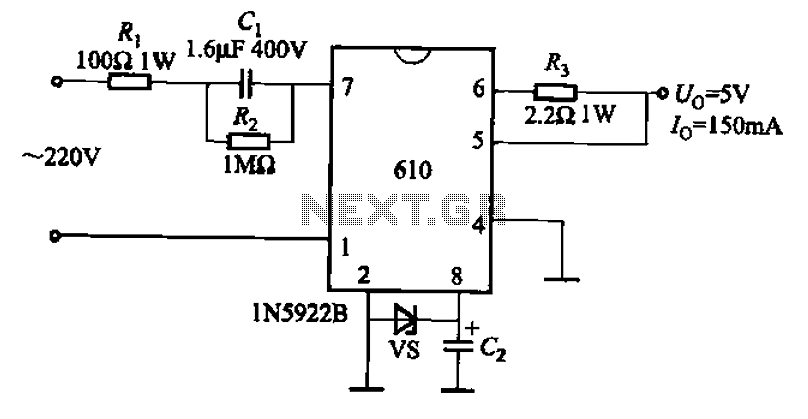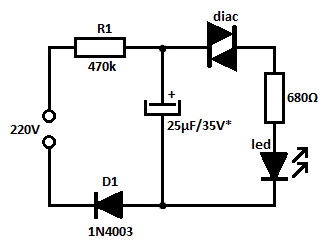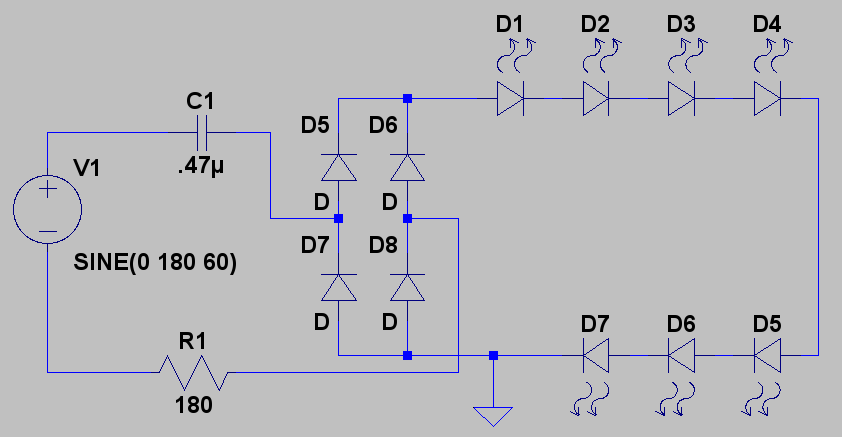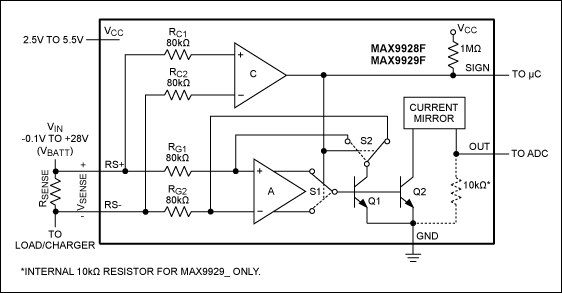
Low current consumption lamp flasher
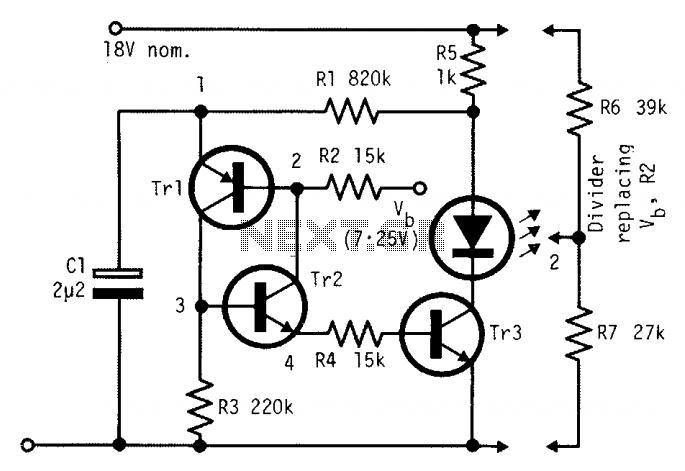
The circuit is economical in components and can operate with virtually any transistors, ensuring reliable self-starting functionality. The voltage Vb can be derived from a voltage divider, as illustrated. However, if Vb is sourced from a fixed voltage, the flashing rate decreases as the battery voltage diminishes. The minimum drive current into the base of transistor Tr3 is calculated as (Vb - 0.6 V) / (R2 + R4). Resistor R4 restricts the initial current from capacitor C1, and it is noted that R2 and R4 can be approximately equal when a voltage divider is employed for Vb. The value of resistor R2 is given by R6R7 / (R6 + R7). Based on the specified voltages and with R2 equal to R4, the on-time is approximately 1.1 C1R2, while the off-time is about 0.28 C1R1.
Using the indicated component values, the total period is around 0.55 seconds, with a duty cycle of approximately 7% and a mean battery current, including the Vb divider, of about 1.5 mA.
The circuit described is a simple astable multivibrator configuration that utilizes transistors for generating a square wave output. The choice of transistors is flexible, allowing for various types, which contributes to the circuit's cost-effectiveness. The self-starting nature of the circuit is a significant advantage, ensuring that it begins oscillation without external triggering.
The voltage divider for Vb is critical in determining the base current for Tr3, which affects the oscillation frequency. When Vb is supplied from a fixed voltage source, the circuit's performance becomes sensitive to battery voltage levels, leading to slower flashing as the battery discharges. This behavior should be considered when designing for applications where battery life is a concern.
Resistor R4 plays a vital role in controlling the initial charging current of capacitor C1, which influences the timing characteristics of the circuit. The relationship between R2 and R4, particularly when they are set to equal values, simplifies the design process and allows for predictable timing intervals. The calculation of R2 as R6R7 / (R6 + R7) indicates the importance of selecting appropriate resistor values to achieve the desired timing characteristics.
The timing of the circuit is dictated by the capacitance of C1 and the resistance values of R2 and R1. The on-time and off-time calculations provide a framework for tuning the circuit to achieve specific operational requirements. The resulting period of 0.55 seconds and duty cycle of 7% suggest that this circuit is suitable for low-power applications, where minimal current draw is essential.
Overall, the described circuit is a reliable and efficient solution for generating periodic signals, with flexibility in component selection and straightforward design principles.The circuit is economical in components, and will work with virtually any transistors and is reliably self-starting. The voltage Vb can be taken from a divider, as shown at the right. If taken from a fixed source, flashing becomes slower as battery voltage falls. The lowest drive current into the base of Tr3 is about (Vb—0,6 V)/(R2 + R4). Resistor R4 limits the initial current from Cl and, as shown, R2 and R4 can be roughly equal when a divider is used for Vb.
Resistor R2 equals R6R7/(R6 + R7). With the voltages shown, and with R2 = R4, the on-time is about 1.1 C1R2 and the off-time about 0.28 C1R1. Using the component values shown the period is about 0.55 sec. with a duty cycle of about 7% and a mean battery current including the Vb divider, about 1.5 mA. 🔗 External reference
Using the indicated component values, the total period is around 0.55 seconds, with a duty cycle of approximately 7% and a mean battery current, including the Vb divider, of about 1.5 mA.
The circuit described is a simple astable multivibrator configuration that utilizes transistors for generating a square wave output. The choice of transistors is flexible, allowing for various types, which contributes to the circuit's cost-effectiveness. The self-starting nature of the circuit is a significant advantage, ensuring that it begins oscillation without external triggering.
The voltage divider for Vb is critical in determining the base current for Tr3, which affects the oscillation frequency. When Vb is supplied from a fixed voltage source, the circuit's performance becomes sensitive to battery voltage levels, leading to slower flashing as the battery discharges. This behavior should be considered when designing for applications where battery life is a concern.
Resistor R4 plays a vital role in controlling the initial charging current of capacitor C1, which influences the timing characteristics of the circuit. The relationship between R2 and R4, particularly when they are set to equal values, simplifies the design process and allows for predictable timing intervals. The calculation of R2 as R6R7 / (R6 + R7) indicates the importance of selecting appropriate resistor values to achieve the desired timing characteristics.
The timing of the circuit is dictated by the capacitance of C1 and the resistance values of R2 and R1. The on-time and off-time calculations provide a framework for tuning the circuit to achieve specific operational requirements. The resulting period of 0.55 seconds and duty cycle of 7% suggest that this circuit is suitable for low-power applications, where minimal current draw is essential.
Overall, the described circuit is a reliable and efficient solution for generating periodic signals, with flexibility in component selection and straightforward design principles.The circuit is economical in components, and will work with virtually any transistors and is reliably self-starting. The voltage Vb can be taken from a divider, as shown at the right. If taken from a fixed source, flashing becomes slower as battery voltage falls. The lowest drive current into the base of Tr3 is about (Vb—0,6 V)/(R2 + R4). Resistor R4 limits the initial current from Cl and, as shown, R2 and R4 can be roughly equal when a divider is used for Vb.
Resistor R2 equals R6R7/(R6 + R7). With the voltages shown, and with R2 = R4, the on-time is about 1.1 C1R2 and the off-time about 0.28 C1R1. Using the component values shown the period is about 0.55 sec. with a duty cycle of about 7% and a mean battery current including the Vb divider, about 1.5 mA. 🔗 External reference

